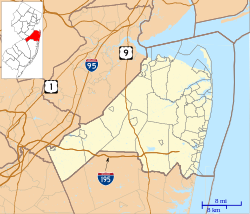Old Scots Burying Ground | |
 | |
| Location | Gordon's Corner Road, Marlboro Township, New Jersey |
|---|---|
| Coordinates | 40°20′23″N74°15′35″W / 40.33972°N 74.25972°W |
| Area | 1 acre (0.40 ha) |
| Built | 1692 |
| Architect | J & R Lamb Studio |
| NRHP reference No. | 01000841 [1] |
| NJRHP No. | 3777 [2] |
| Significant dates | |
| Added to NRHP | August 15, 2001 |
| Designated NJRHP | June 19, 2001 |
The Old Scots Burying Ground is a historic cemetery located on Gordon's Corner Road in the Wickatunk section of Marlboro Township, in Monmouth County, New Jersey. It was added to the National Register of Historic Places on August 15, 2001, for its significance in history and religion. [3] The Old Scots Burying Ground is about an acre in size, [4] about 195 feet above sea level [5] and dates back to 1685. [6] [7] The total number of burials at the cemetery is not precisely known, suggested by Symms, "There are a large number of graves in Old Scots yard without any inscribed stones". [8] Some reports place the number as at least 100 known graves [9] with most headstones of brown sandstone. However, more recent research using ground penetrating radar reported by the Old Tennent Church in 2001 has put the number of confirmed sites at about 122 graves with a possible 140 more unmarked; placing the number at about 262 total graves in the cemetery. [10] In 1945, in an attempt to clean out the site of vegetation and over-growth, a bulldozer was used on the property and as a result some headstones were dislodged and broken stones removed. [3] The defining structure in the cemetery is a tall monument to Rev. John Boyd, created by the J&R Lamb Company. [11] Built to commemorate the first recorded Presbyterian ordination of Rev. John Boyd. [12] The monument is currently owned by the Synod of the Northeast who holds the property deed but it is maintained by the Old Tennent Church. The last identified burial was in 1977.



